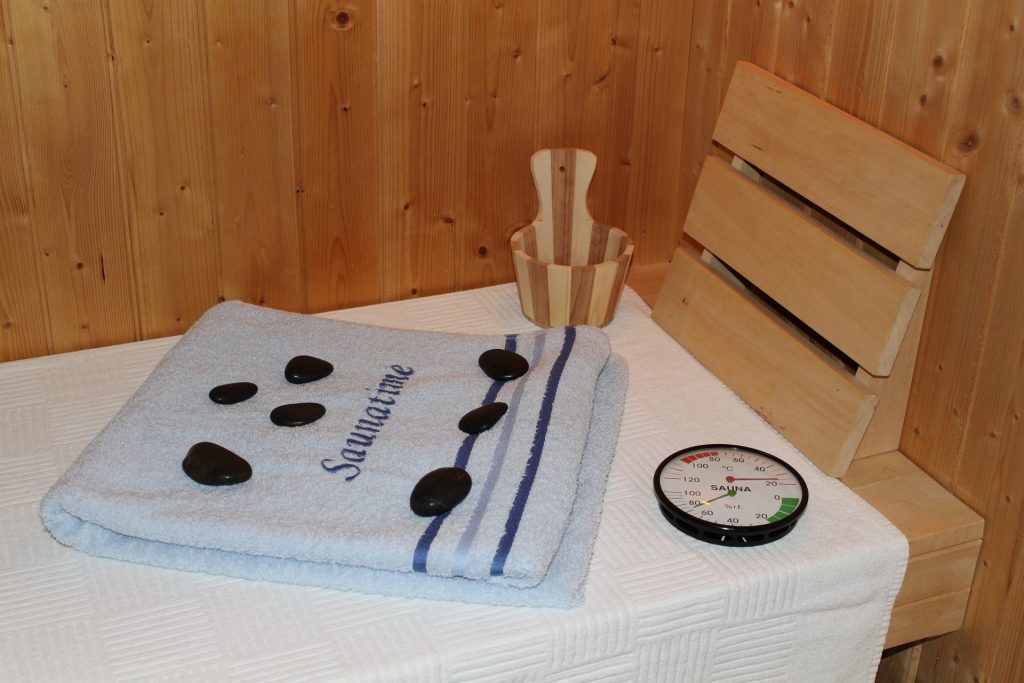After a strenuous workout or a long day at the office, there is nothing more stunning, fulfilling, or relaxing than going to a sauna and sealing the door behind you. This lovely time allows you to relax, cleanses your body, and kickstarts your fat burning, all at the same time.
On the other hand, much like the vast majority of beneficial things, saunas have been found to have a few downsides. According to a number of studies, being in this serene environment for an extended period of time may be harmful to one's health. Everyone is left thinking, "How long should you spend in a sauna?" as a consequence of this development.
This article is devoted to those readers who are interested in experiencing the exhilaration of putting their bodies through intense heat while also enjoying the therapeutic advantages of using a sauna. But before we delve into this hotly disputed topic, let's find out why going to a sauna is beneficial to your health.
There is no argument that going to a sauna is a calming experience; after all, people have been doing so for thousands of years. The process of sweating can be a beneficial technique to purge toxins from your body and even refresh your skin. Sweating requires additional effort from your body, which results in the burning of additional calories. A single session in a sauna has been observed to cause weight loss of up to five pounds in some individuals, and athletes often utilize them to help them make weight before contests.
Because there are considerable effects that high temperatures have on the body, there are a whole host of variables that have the potential to become the most crucial component. Your heart is beating extremely quickly (by an increase of thirty percent or more, which multiplies the amount of blood it siphons every single instant), you are sweating an excessive amount, and your pulse is going up and down. In a similar vein, when it comes to the most helpful things, you should always make sure to follow security safety precautions and spend the least amount of time possible inside.
As a general rule, the greatest amount of exposure that you should be getting in a single session should not exceed twenty minutes. Because of the uniqueness of each individual, it is possible that this overarching example does not directly relate to you. Always make it a point to pay attention to what your body is trying to tell you. Get out of the steam room if you start to feel unduly exhausted or if the temperature starts to rise too high. It is illogical to stay inside only because the twenty-minute restriction has not yet been met if your body is indicating that you should go outside. Keep in mind that going inside a steam room is meant to be a relaxing experience. If you find that you are trying to tough it out despite the discomfort, you may be keeping yourself locked up for too long.
Building up a sensitivity to the heat should be one of the first things that should be considered. Although the maximum length of time that you should spend in a sauna is around 25 to 35 minutes (lower for individuals with health conditions such as high blood pressure), you should not seek to stay in the sauna for that long on your very first visit. Instead, work on building up your tolerance. The experts on sauna baths suggest beginning with ten to fifteen minutes, during which time you should be sure to replenish your fluids, and then gradually increasing the amount of time spent in the sauna with each visit.
FAQs About Sauna
The heat of the sauna would help to soften the muscle tissues allowing a deeper massage with less pain to tense areas, so I would advise having a massage after a sauna. It is worth remembering that saunas encourage sweating and hence a loss of body fluid.
What is the best temperature for a Sauna? The appropriate temperature for a sauna depends on your preference! Most people prefer to enjoy their sauna at temperatures between 150-175 degrees Fahrenheit for traditional saunas and 120-130 degrees Fahrenheit for infrared saunas.
Wearing something comfortable made of cotton is the best thing you can wear in a sauna. A classic oversized t-shirt, a loose-fitting cotton towel, and shorts are always good for the sauna. They allow your skin to breathe freely; this helps you enjoy a sauna session to its full potential.
Saunas are excellent for relaxation and relieving tense muscles. Meanwhile, steam rooms have further benefits from the moist heat and humidity such as skin moisturizing, congestion relief, and reduced muscle soreness.
You might crave something salty post sauna session because you lost a good amount of sodium via sweating. Although tempting, don't reach for a bag of chips. Instead opt for foods that are nutrient dense like leafy greens, nuts, bananas or fruits high in water like pineapple or watermelon.
Sauna for beginners
Those who are new to the sauna should initially sit on one of the lower benches. Utilizing the higher benches, which are typically hotter, for intense but brief bouts of sweating is the most efficient method for experienced sauna users. Before you exit the sauna, you need to adjust your circulation to an upright posture by sitting on the lower benches for about two minutes. This will allow your muscles to relax and your blood to flow more freely. After being exposed to heat, for the best possible health benefits, you should have a chilly shower, and then, if you're a seasoned sauna regular and don't have hypertension, you should finish off with a dip in the freezing water of a diving pool.
During your time in the sauna, please keep in mind that your health and well-being are the most essential considerations. It is imperative that you exit the sauna immediately and allow your body to rest if you are not feeling well or have other symptoms.
The standard number of sauna sessions during a visit to the sauna is three, but this number can vary depending on the individual. In the event that one goes to the sauna more than once a week, the amount of time spent in the sauna should be cut down in order to avoid putting unnecessary strain on the body.
Is it your first sauna bath – do you sauna regularly?
If you use common sense, you should know that your first trip in the sauna will be the one in which you experience the most discomfort, while subsequent visits should get progressively easier. After a couple of sessions, you will find that you want to remain in the sauna for longer and longer periods of time.
The recommendation for first-time users is applicable to each and every kind of sauna. When utilizing the sauna for the very first time in your life, you need to take it easy and limit your session to no more than 15 minutes.
You need to go out of the house as soon as you begin to feel uneasy so that you may give your body time to gradually calm down. In this kind of predicament, it is not a good idea to take a cold shower or blend hot and cold water in any way. Allow it to happen gradually.
If everything seems to be in order and you are feeling fine, you may give the sauna another shot; however, you should prevent staying there for more than ten to fifteen minutes at a time. You will be able to remain in the sauna for longer and longer periods of time as your body becomes accustomed to the treatment.
How frequently? In the beginning, it will be sufficient to have only a few sessions per week. After some time, you'll be able to make daily use of it.
Over time, your body will adjust to the heat of the sauna in many different ways. It adjusts the level of hormones, the cardiovascular system, the immunological system, and the nervous system. Even your skin will adjust to the conditions in the sauna. When you go to a Finnish sauna for the fifth or sixth time, as opposed to the first or second time, you can anticipate being able to remain in the bath for a longer period of time. But bear in mind that if you are utilizing an infrared sauna, you should only stay in there for a maximum of 45 minutes at a time.
How long should I stay in a sauna?
If you've never been in a sauna before, there is widespread consensus among authorities on the practice, such as the American College of Sports Medicine, the American Sauna Society, and seasoned sauna bathers:
- You need to get things started slowly.
- For beginners. The use of a sauna for longer than five to ten minutes at a time is not recommended.
- After finishing the workout. After you've finished exercising, you should wait at least ten minutes before entering the sauna.
- At maximum. You shouldn't spend more than around fifteen minutes at a time in the sauna at a time.
Be careful not to spend too much time in the sauna; some people, particularly in Finland, like to make it into a longer social occasion than it actually is. Because the risk of becoming dehydrated increases in proportion to the length of time spent in the sauna, the standard recommendation is to limit your time there to no more than fifteen to twenty minutes.
Since the sauna's purpose is to relax rather than to keep track of the amount of time spent inside, the Finnish people, from whom we get the word "sauna," may have a recommendation that is even easier to follow: exit the sauna as soon as you begin to feel too hot.
Continue reading to learn why it might be beneficial for your health to spend a few minutes in the sauna on a regular basis.
How much is too much?
Indeed, it is a difficult problem to solve. The vast majority of us are under the impression that Swedes and Finns spend a considerable amount of time in the sauna. They use it as a gathering spot for their friends and family.
However, you shouldn't put too much stock on everything you see in the movies. Spending an excessive amount of time in the sauna can lead to a significant loss of body fluids, which can have negative effects on your health. In point of fact, persons who are already skilled in utilizing the sauna should not stay in there for more than thirty to forty-five minutes at a time.
You are allowed to use the sauna 2 or 3 times during the course of a single session; however, you should take breaks and allow yourself to cool down in between each usage. It is recommended that you wait ten to twenty minutes before entering the building again after taking a break.
Because the high temperature has such deep impacts on the body, a wide variety of other issues come into play as a result of these consequences. Your heart is pumping blood at a higher pace (the pulse might spike to 30 percent or more, which doubles the amount of blood it pumps every minute), you are sweating a lot (which causes you to get dehydrated), and your blood pressure is going up and down. Be sure to take all necessary safety procedures, and try to spend as little time as possible inside the building.
Is it healthy to spend an hour in a sauna without getting out? Building up a tolerance to heat should be one of the first things that should be considered. Although the maximum length of time you should spend in a sauna is roughly 30 to 45 minutes (this duration should be reduced for those with health conditions such as high blood pressure), you should not seek to stay in the sauna for that long on your very first visit. Instead, work on building up your tolerance. It is recommended by professionals to begin with ten to fifteen minutes, making sure to replenish fluids afterward, and then gradually increase the amount of time spent exercising with each successive session.
THREE SESSIONS
The standard number of sauna sessions during a visit to the sauna is three, but this number can vary depending on the individual. In the event that one goes to the sauna more than once a week, the amount of time spent in the sauna should be cut down in order to avoid putting unnecessary strain on the body.
Pay attention to the way that you currently feel. When you take a sauna bath for the first time, you might feel the urge to get out after just a few minutes, but if you find that the temperature is just right for you, you can stay for a little bit longer—but not for more than 15 minutes.
How About Your Heart Health and Blood Pressure?
It has been known for decades that people with heart disease can experience improvements in their cardiovascular function as they age. It's amazing to think about, and it makes everyone here question why health insurance companies don't cover the cost of installing a sauna in people's homes.
Yet, researchers in Finland analysed 102 patients, with a mean age of 52, who all had at least one major cardiovascular risk factor. In the sauna, where the temperature was 73 degrees Celsius and the humidity ranged from 10 to 20 percent, they spent a total of 30 minutes once. Patient's BP dropped and stayed much below earlier readings. This had a major effect on the arterial stiffness. Even the right ventricle of the left heart was better able to pump blood after a session in the sauna.
In Switzerland, 37 male patients with chronic heart failure or coronary artery disease were carefully observed by specialists at Bern University after they were subjected to 80 degree Finnish sauna temperatures followed by immersion in cold water at 12 degree Celsius. They didn't want to risk hypothermia, so the men didn't immerse their entire heads.
Patients with chronic heart failure saw significant increases in cardiac output and decreases in heart rate, as well as decreases in blood pressure. Only after using the sauna did patients with coronary artery disease benefit.
The Kuopio Ischemic Heart Disease, Risk Factor Study found that regular sauna use reduced the risk of death from cardiovascular disease in males by 27% compared to men who never used a sauna. Men who spent four to seven hours per week in a sauna had a 50% reduced chance of dying from heart disease. If you identify as a manly man, how long do you think you need to spend in the sauna? At least 19 minutes is the right time.
You are now prepared to enter any type of sauna, whether it be an indoor or outdoor sauna, Finnish or infrared sauna, do-it-yourself sauna, or portable sauna. The next move will be your responsibility.
How to use a sauna properly?
A sauna, when used appropriately, reduces the risk of experiencing unwanted side effects while also ensuring that the device serves the function for which it was designed.
In order to make appropriate use of the facility, you will need to observe the following safety procedures and follow the advice presented below:
- To prevent a sudden drop in body temperature, give yourself some time to prepare before getting into your cool shower. It will take some time for your body to acclimate to the sudden change from the hot steam to the cool bath. This helps to prevent any shock that may occur when there is a quick change in the temperature of the body from high to low.
- Be sure to drink plenty of water before entering the sauna. The use of a sauna causes you to break out in sweat, which results in the loss of water from your body. In order to avoid becoming dehydrated, it is essential to drink a lot of water before going into the sauna. This will ensure that the water that will be lost through sweating is restored as soon as possible. Dehydration is dangerous to your body and can lead to heat stroke if left untreated. Additionally, before and throughout your sauna session, you should abstain from drinking beverages that can lead to dehydration. Alcohol is one example of such a beverage.
- Stay away from the sauna after you've had a big dinner. The digestion of a rich meal requires a significant amount of effort. This prevents your body from gaining the necessary energy to sweat while you are in the sauna. You need to give your body enough time to recover from the meal before you go into the sauna, so make sure you get enough rest after eating.
- Before using the sauna for the first time, you should always read the included instructions. When utilizing the facility, it is important to follow the guidelines, heed the warnings, and pay attention to the safety precautions that are outlined in the instructions. Because the rules can change from one sauna to the next, it is best not to make assumptions but rather to study the rules beforehand.
- If you are just starting out, start with a lower temperature and gradually work your way up. Your body is protected against the heat shock that might be caused by a sudden shift in temperature thanks to this.
- When you start to feel uneasy, you should get out of the sauna as soon as possible. Your body was not designed to be exposed to high temperatures for an extended period of time. It is important to remember that using the sauna for longer than 15 or 20 minutes at a time can be dangerous.
Sauna time limit
Time constraints are generally not strictly enforced. There is not a safety monitor standing inside the sauna waiting to blow her whistle and warn you that your thirty minutes are up when you get to the end of your session. Instead, you should time yourself and look for signs inside the spa or gym that indicate how long you are allowed to spend there.
First and foremost, you should pay attention to your body. Even though you might be planning on working out for a longer period of time, you should take a break if you begin to experience symptoms such as lightheadedness, dizziness, or extreme overheating. Take some time off to allow your body to restore to its normal temperature, and if you still don't feel completely at ease, you can try again. Another perk of using a sauna is the opportunity to catch up with a friend in peace and quiet. If you want to make the most of this perk, consider inviting a companion along with you.
Spending time in a sauna may be both pleasant and beneficial to your health; however, sessions should not go longer than 60 minutes. You won't have to wait long before you notice the positive effects.
If this is your first time working out in heat or steam, you shouldn't spend more than ten minutes at a time in either environment. As your body becomes accustomed to the practice, you should gradually lengthen the time you spend there to anywhere between ten and fifteen minutes.
If the sauna has more than one bench, you can experiment by moving between the lower and upper levels to locate the one that gives you the most pleasant temperature. However, if you are a seasoned user, you can utilize the hotter benches (located higher up) to induce a more intense sweating response. However, once you are finished with the sessions, you should be sure to sit on the benches that are located lower down so that your body can acclimate to the new environment.
However, the majority of establishments that operate infrared saunas permit sessions of up to thirty minutes in length. This is due to the fact that humans are better able to tolerate infrared heat than steam heat.
Traditional steam saunas reach extremely high temperatures and heat the air all around you to create the sensation of being in a cloud of steam. The process of sweating begins when the body reacts to the higher temperature in its environment by producing more perspiration. Due to the fact that not everyone is able to tolerate this temperature, there aren't very many people who are able to make it through more than the first 15 minutes of the practice.
On the other side, infrared saunas heat your body through exposure to infrared light rather than traditional steam. This, in contrast to its steam equivalent, causes you to sweat more by directing the red light straight into your body, which promotes the sweating effect. Because there is no heat that goes to warm the air around you, you will perspire more even though the temperature is lower than normal. This is one of the causes why a lot of people are able to confidently complete a session that lasts for thirty minutes.
When Is Sauna Not Good For You?
Unfortunately, not everyone can read them, and there are times when you shouldn't shut yourself in a sauna even if you can. The health benefits of saunas are numerous; however, not everyone can read them. It is possible that spending time in a hot room or a steam room will do you more harm than benefit if you are being treated for a medical condition or are already ill.
If you have a condition related to your heart or another health issue, how long should you spend in a sauna?
When you have a condition that could potentially take your life, you should not even entertain the idea of putting your body through extreme heat. But if you absolutely have to, then get the okay from your primary care physician before you leave.
Even though numerous studies have demonstrated that the increased heart rate that a sauna induces is not a reason for concern for individuals who are physically fit or those who have a coronary disease that is stable, there are certain individuals who should not use a sauna unless they have received permission to do so from a medical professional. These are the following:
- Women who are pregnant and have children in their early years
- Those individuals who are incapable of thinking clearly due to the effects of alcohol and/or other drugs
- Those who suffer from conditions such as diabetes or cardiovascular issues
- Individuals who are taking medications that require a prescription.
When using a sauna or a steam room, one of the most essential things to keep in mind is to go slow and steady with the sessions. Even while saunas are commonly considered to be safe and may provide some possible health advantages, it is essential to take precautions against dehydration. Also, keep in mind that the way you feel and the way your body reacts to the heat may vary from one occasion to the next.
Do not make the mistake of thinking that using a sauna to lose weight would result in anything other than water loss. Always remember to rehydrate with water before and after you use the sauna. If you are concerned, you should discuss your visit to a sauna with your primary care physician first.
Talk to the staff at the location of the sauna to get pointers, answers to any concerns you might have, and directions regarding what to anticipate while you're there. If you are pregnant, you should talk to your healthcare provider before using a sauna.
A trip to the sauna should be one that leaves one feeling relaxed and refreshed at the end of the day. Do not forget to unwind, take some deep breaths, and savor the moment.
In a nutshell, the usage of a sauna has a number of health benefits for your body, including the reduction of stress, the elimination of toxins from your body, the cleansing of your skin, and the improvement of blood circulation.
In addition to these benefits, it can aid in the prevention of sickness, the alleviation of discomfort in the muscles and joints, and the promotion of restful sleep.
You will not, however, be able to make use of these benefits unless you make proper use of the apparatus.
Keep in mind that your body was not designed to handle extreme temperatures for extended periods of time, since doing so may be detrimental to your health and well-being.
Now that you understand what a sauna is and why it is used, you need to make sure that you observe some critical precautions before entering the facility that houses the sauna.
It doesn't matter if you're using a portable sauna that you've set up in your own house or the one at the fitness center down the street: the length of time you spend in the sauna can have both a beneficial and a bad effect on you. Because of the potential risks to your health, your body was not designed to withstand extreme temperatures for an extended period of time. Therefore, try to keep your workouts as brief as possible while still getting the most out of them.
Be sure to have plenty of water before you leave, keep an eye out for any signs of pain, and if you have any condition that affects your heart, consult your primary care physician for guidance. Also, keep in mind that saunas do not alleviate the symptoms of a hangover, so after a night of drinking, this is absolutely not the environment in which you should be.
Conclusion
Saunas can be beneficial to health, but they can also have negative effects, such as increased heart rate and sweating, so it is important to follow security safety precautions and spend the least amount of time inside. The maximum amount of exposure to heat in a sauna should not exceed twenty minutes, and it is important to pay attention to your body's signals and build up a sensitivity to the heat by gradually increasing the amount of time spent in the sauna with each visit. First-time sauna users should limit their sessions to no more than 15 minutes and go out of the house as soon as they begin to feel uneasy. The most important details are that the body adjusts to the heat of the sauna over time, and that it is beneficial for health to spend a few minutes in the sauna on a regular basis. Excessive time in a sauna can lead to a loss of body fluids and other health issues, so it is important to take safety precautions and build up a tolerance to heat.
Regular sauna use reduces the risk of death from cardiovascular disease in males by 27%, with men who spend four to seven hours per week having a 50% reduced chance. The most important details are to drink plenty of water before entering a sauna to prevent dehydration and prevent heat stroke. When using the sauna, it is important to follow the guidelines, heed warnings, and pay attention to safety precautions. Time constraints are not strictly enforced, so it is important to pay attention to your body and take breaks if necessary. Sessions should not go longer than 60 minutes.
Sauna can have many health benefits, but it is important to get permission from a medical professional before using it. Pregnant women, those with mental health issues, and those taking medications should take precautions against dehydration and rehydrate before and after using a sauna. Saunas have a number of health benefits, such as reducing stress, eliminating toxins, and improving blood circulation, but must be used properly.
Content Summary
- But before we delve into this hotly disputed topic, let's find out why going to a sauna is beneficial to your health.
- Instead, work on building up your tolerance.
- During your time in the sauna, please keep in mind that your health and well-being are the most essential considerations.
- After a couple of sessions, you will find that you want to remain in the sauna for longer and longer periods of time.
- Allow it to happen gradually.
- Spending an excessive amount of time in the sauna can lead to a significant loss of body fluids, which can have negative effects on your health.
- Instead, work on building up your tolerance.
- Yet, researchers in Finland analysed 102 patients, with a mean age of 52, who all had at least one major cardiovascular risk factor.
- If you identify as a manly man, how long do you think you need to spend in the sauna?
- At least 19 minutes is the right time.
- Be sure to drink plenty of water before entering the sauna.
- Additionally, before and throughout your sauna session, you should abstain from drinking beverages that can lead to dehydration.
- Stay away from the sauna after you've had a big dinner.
- Sauna time limit
- Instead, you should time yourself and look for signs inside the spa or gym that indicate how long you are allowed to spend there.
- Another perk of using a sauna is the opportunity to catch up with a friend in peace and quiet.
- It is possible that spending time in a hot room or a steam room will do you more harm than benefit if you are being treated for a medical condition or are already ill.
- If you have a condition related to your heart or another health issue, how long should you spend in a sauna?When you have a condition that could potentially take your life, you should not even entertain the idea of putting your body through extreme heat.
- When using a sauna or a steam room, one of the most essential things to keep in mind is to go slow and steady with the sessions.
- Always remember to rehydrate with water before and after you use the sauna.
- If you are pregnant, you should talk to your healthcare provider before using a sauna.
- In a nutshell, the usage of a sauna has a number of health benefits for your body, including the reduction of stress, the elimination of toxins from your body, the cleansing of your skin, and the improvement of blood circulation.






